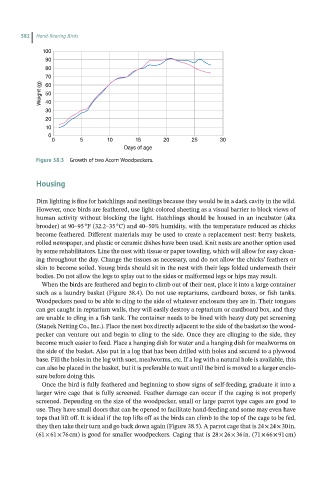Page 581 - Hand rearing birds second
P. 581
582 Hand-Rearing Birds
100
90
80
70
Weight (g) 60
50
40
30
20
10
0
0 5 10 15 20 25 30
Days of age
Figure 38.3 Growth of two Acorn Woodpeckers.
Housing
Dim lighting is fine for hatchlings and nestlings because they would be in a dark cavity in the wild.
However, once birds are feathered, use light‐colored sheeting as a visual barrier to block views of
human activity without blocking the light. Hatchlings should be housed in an incubator (aka
brooder) at 90–95 °F (32.2–35 °C) and 40–50% humidity, with the temperature reduced as chicks
become feathered. Different materials may be used to create a replacement nest: berry baskets,
rolled newspaper, and plastic or ceramic dishes have been used. Knit nests are another option used
by some rehabilitators. Line the nest with tissue or paper toweling, which will allow for easy clean-
ing throughout the day. Change the tissues as necessary, and do not allow the chicks’ feathers or
skin to become soiled. Young birds should sit in the nest with their legs folded underneath their
bodies. Do not allow the legs to splay out to the sides or malformed legs or hips may result.
When the birds are feathered and begin to climb out of their nest, place it into a large container
such as a laundry basket (Figure 38.4). Do not use reptariums, cardboard boxes, or fish tanks.
Woodpeckers need to be able to cling to the side of whatever enclosure they are in. Their tongues
can get caught in reptarium walls, they will easily destroy a reptarium or cardboard box, and they
are unable to cling in a fish tank. The container needs to be lined with heavy duty pet screening
(Stanek Netting Co., Inc.). Place the nest box directly adjacent to the side of the basket so the wood-
pecker can venture out and begin to cling to the side. Once they are clinging to the side, they
become much easier to feed. Place a hanging dish for water and a hanging dish for mealworms on
the side of the basket. Also put in a log that has been drilled with holes and secured to a plywood
base. Fill the holes in the log with suet, mealworms, etc. If a log with a natural hole is available, this
can also be placed in the basket, but it is preferable to wait until the bird is moved to a larger enclo-
sure before doing this.
Once the bird is fully feathered and beginning to show signs of self‐feeding, graduate it into a
larger wire cage that is fully screened. Feather damage can occur if the caging is not properly
screened. Depending on the size of the woodpecker, small or large parrot type cages are good to
use. They have small doors that can be opened to facilitate hand‐feeding and some may even have
tops that lift off. It is ideal if the top lifts off as the birds can climb to the top of the cage to be fed,
they then take their turn and go back down again (Figure 38.5). A parrot cage that is 24 × 24 × 30 in.
(61 × 61 × 76 cm) is good for smaller woodpeckers. Caging that is 28 × 26 × 36 in. (71 × 66 × 91 cm)

